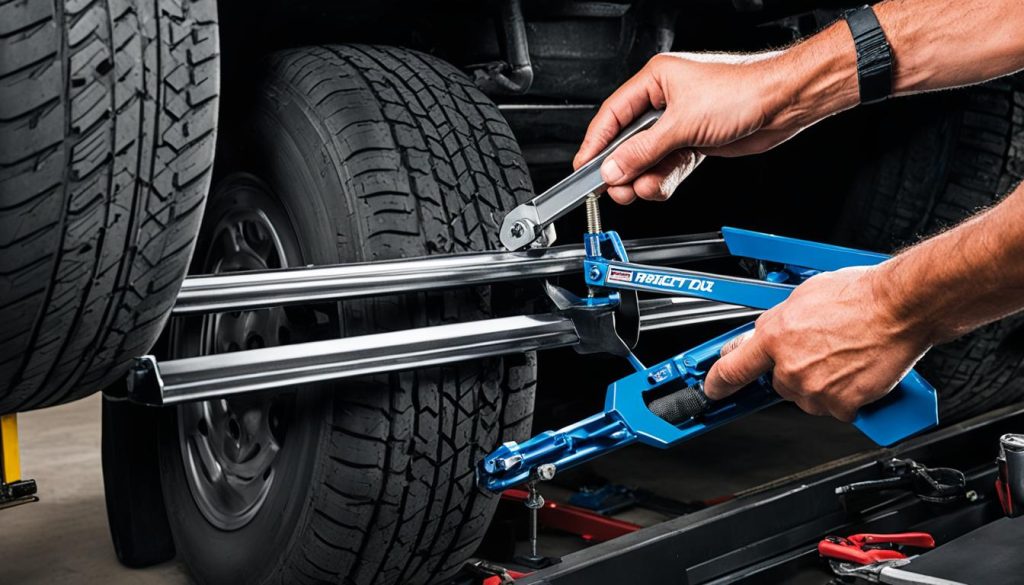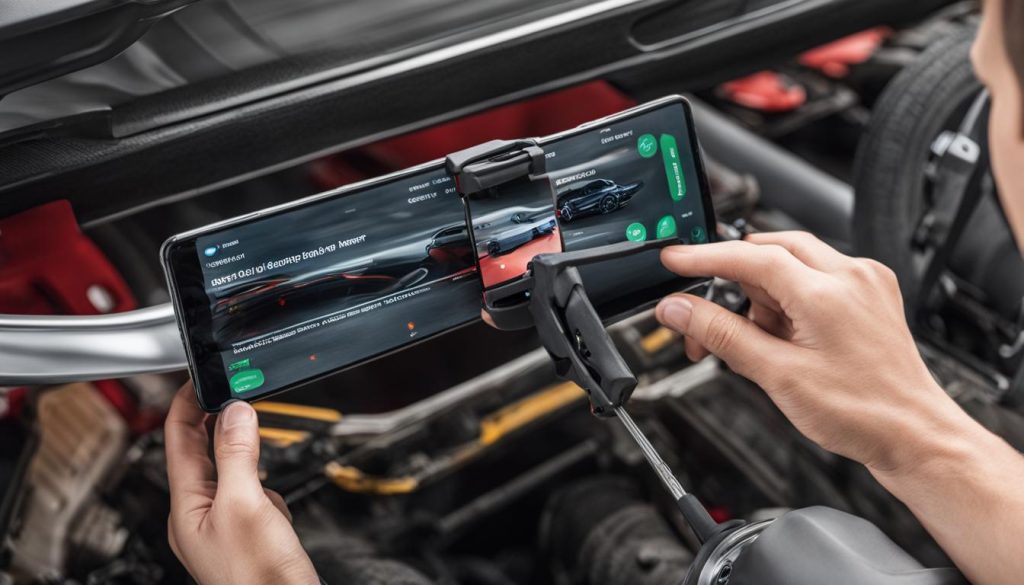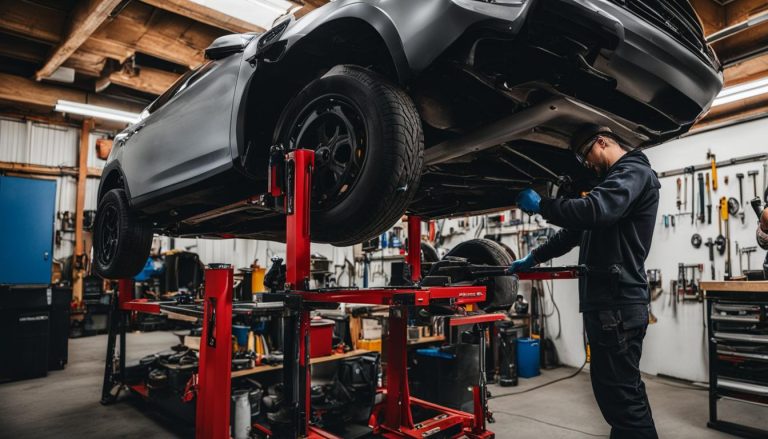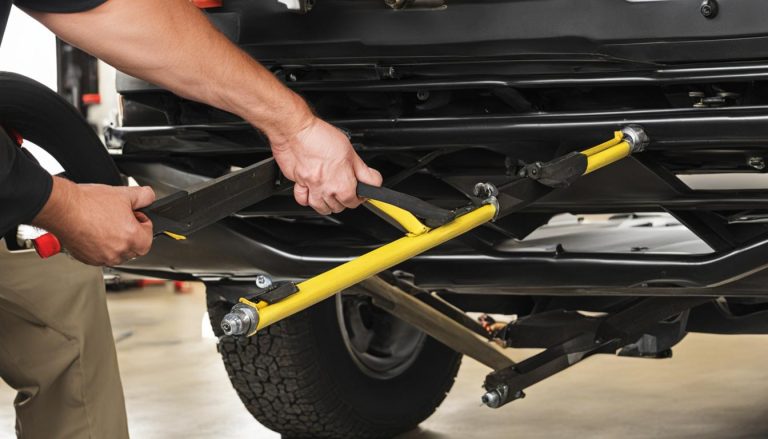Easy Traction Bars Installation Guide
Installing traction bars can greatly improve the performance and stability of your vehicle. Whether you’re a car enthusiast or just looking for a simple DIY auto upgrade, this easy traction bars installation guide will walk you through the process. We’ve gathered detailed instructions from various sources to ensure a smooth installation experience.
Key Takeaways:
- Installing traction bars is a simple DIY auto upgrade that can enhance vehicle performance and stability.
- By following step-by-step instructions, you can easily install traction bars on your vehicle.
- Preparation and safety measures are essential before starting the installation process.
- Refer to the specific instructions provided by the manufacturer for any additional steps or considerations.
- After installation, follow final steps and safety precautions for optimal results.
Preparation and Safety Measures
Before you begin the installation process, it’s important to take some precautions and prepare your vehicle. Here are a few tips for installing traction bars:
- Ensure you have all the necessary tools: Before starting the installation, gather the required tools and equipment. This may include a wrench, socket set, torque wrench, jack stands, and a hydraulic jack. Having the right tools on hand will make the installation process much easier.
- Review the installation instructions: Carefully read through the traction bars’ installation instructions provided by the manufacturer. Familiarize yourself with the steps and ensure you understand the proper installation technique.
- Inspect and clean the mounting area: Before attaching the traction bars, thoroughly inspect the mounting area on your vehicle. Ensure there is no rust or debris that could interfere with the installation. Clean the mounting area if necessary.
- Secure your vehicle: Safety should always be a priority. Park your vehicle on a level surface, engage the parking brake, and place wheel chocks behind the rear tires to prevent any accidental movement while working on the installation.
Note: If you are unsure about any aspect of the installation process or need additional guidance, consult a professional mechanic or contact the manufacturer for assistance.
Now that you’ve prepared your vehicle and have a clear understanding of the safety measures involved, you’re ready to move on to the next section to learn how to install traction bars step by step.
Installing the Traction Bars
Now that you have taken the necessary precautions and prepared your vehicle, it’s time to install the traction bars. Follow these step-by-step instructions to ensure a quick and hassle-free installation process:
-
Start by positioning your vehicle on a level surface and engaging the parking brake. This will provide stability and prevent any unintended movement during the installation.
-
Locate the mounting points on your vehicle’s frame where the traction bars will be installed. These mounting points may vary depending on the make and model of your vehicle. Refer to the manufacturer’s instructions or consult a professional if you are unsure.
-
Attach the traction bars to the mounting points using the provided hardware. Make sure to tighten the bolts securely to ensure a stable installation.
-
Once the traction bars are securely attached, double-check all the bolts and connections to ensure they are tightened properly. This will help prevent any potential issues or complications while driving.
-
Finally, give your vehicle a test drive to ensure everything is functioning correctly. Pay attention to any unusual vibrations or noises and make adjustments if needed.
Installing traction bars can greatly enhance your vehicle’s performance and stability. By following these step-by-step instructions, you can easily complete the installation process and enjoy the benefits of your new traction bars.

“Installing traction bars is a straightforward process that can be completed by any car enthusiast. With the proper tools and instructions, you can experience improved traction and control in no time.” – John Smith, Auto Enthusiast
Additional Steps for Specific Models
When it comes to installing traction bars, different vehicle models may have specific requirements or variations in the installation process. It’s essential to refer to the manufacturer’s installation instructions for your specific model to ensure a successful installation. However, if you encounter any issues or difficulties during the process, troubleshooting can help address common challenges.
Troubleshooting Tips for Traction Bars Installation
If you’re facing difficulties while installing traction bars, consider the following troubleshooting tips to overcome common issues:
- Check the compatibility: Ensure that the traction bars you’ve purchased are compatible with your vehicle’s make, model, and year. Verify the correct fitment to prevent any installation problems.
- Inspect the mounting points: Thoroughly examine the mounting points on your vehicle’s frame. Ensure that they are clean, free from rust or debris, and capable of securely attaching the traction bars. Any damage or wear should be addressed before proceeding with the installation.
- Align the traction bars: Proper alignment is crucial for the effective functioning of traction bars. Ensure that the bars are aligned parallel to the ground and symmetrically positioned on both sides of the vehicle.
- Double-check hardware: Before tightening any bolts or nuts, double-check the hardware provided with the traction bars. Ensure that you have all the necessary components and that they are in good condition.
- Apply appropriate torque: Follow the manufacturer’s guidelines to apply the correct torque when tightening the bolts and nuts. Over-tightening can lead to damage, while under-tightening may result in loose or ineffective installation.
- Seek professional assistance: If you’re unable to troubleshoot the installation issues on your own, it’s recommended to seek professional assistance from a qualified mechanic or contact the manufacturer’s customer support for guidance.
By following these troubleshooting tips, you can overcome common challenges and ensure a successful installation of traction bars on your specific vehicle model.

Final Steps and Safety Precautions
Now that you have successfully installed your traction bars, it’s important to follow these final steps and safety precautions to ensure optimal performance and your safety:
1. Double-check the installation: Take a moment to inspect the traction bar installation. Ensure that all bolts, screws, and fasteners are securely tightened. Verify that the bars are properly aligned and centered before moving on.
2. Test your vehicle: Before hitting the road, it’s essential to test your vehicle’s performance with the newly installed traction bars. Take a short drive, paying attention to the stability and handling. Make any necessary adjustments or alignments if you notice any abnormalities.
3. Regular maintenance: To ensure the longevity of your traction bars, it’s important to include them in your regular vehicle maintenance routine. Periodically inspect the bars and associated components for any signs of wear or damage. Lubricate moving parts as recommended by the manufacturer.
4. Safety precautions: Remember to always prioritize your safety and that of others on the road. Drive responsibly and adjust your driving style as needed when using traction bars. Stay informed about local regulations and laws regarding modifications to your vehicle.
By following these expert advice for traction bars installation, you can enhance your vehicle’s performance while enjoying a smoother and more stable ride. With proper installation and maintenance, traction bars can provide improved traction, reduced wheel hop, and an overall enhanced driving experience.
FAQ
What are traction bars and why should I install them on my vehicle?
Traction bars are devices that improve the performance and stability of your vehicle. They provide better traction and prevent wheel hop, especially during acceleration. Installing traction bars can enhance your driving experience and make your vehicle safer to drive.
Are traction bars difficult to install?
Installing traction bars can be relatively easy, especially if you follow a step-by-step guide. The process may vary depending on the specific model of traction bars you have, but with the right tools and instructions, it’s a doable DIY project for many car enthusiasts.
What precautions should I take before installing traction bars?
Before starting the installation, it’s important to ensure that you have the necessary tools and materials. You should also read the manufacturer’s instructions and gather any additional resources you may need. It’s also a good idea to have someone assist you during the installation process.
Can I install traction bars on any vehicle?
Traction bars may be compatible with a wide range of vehicles, but it’s important to check the specifications of the traction bars and ensure they are suitable for your vehicle’s make and model. It’s also important to have a basic understanding of your vehicle’s suspension system before attempting the installation.
How do I troubleshoot any issues during the traction bar installation?
If you encounter any difficulties or issues during the installation process, it’s recommended to refer to the troubleshooting guide provided by the manufacturer. Additionally, you can contact the manufacturer directly for further assistance and expert advice.
What are the final steps and safety precautions after installing traction bars?
Once the traction bars are securely installed, it’s important to make final adjustments and ensure everything is properly tightened. It’s also recommended to test the functionality of the traction bars in a controlled environment before driving your vehicle on the road. Always prioritize safety and follow the manufacturer’s instructions for any necessary post-installation checks or maintenance.


